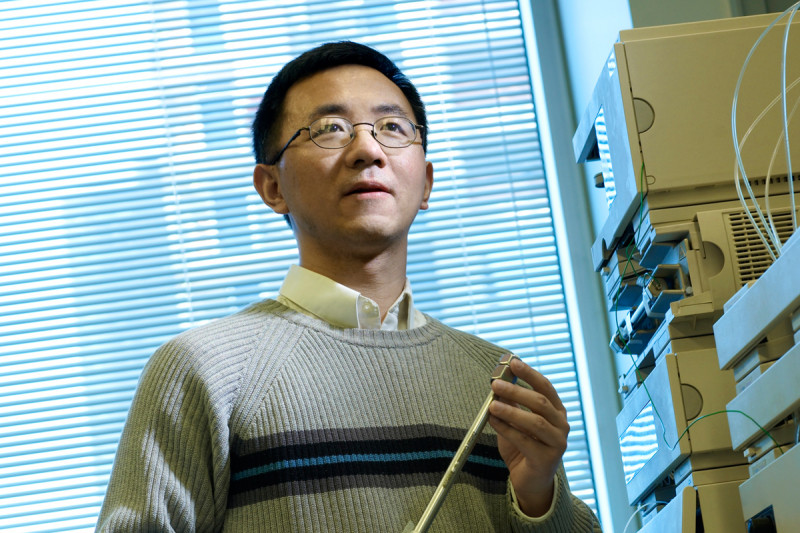
Xuejun Jiang -- Cell Biologist
Cell biologist Xuejun Jiang studies the mysteries of programmed cell death and its role in the formation of tumors. We spoke with Dr. Jiang in 2008, four years after he joined the Sloan Kettering Institute to head his own laboratory.
I’ve always been a bit of a dreamer and wanted to do something interesting and meaningful with my life — something that would have a positive impact. However, after spending seven years at Fudan University, in Shanghai, earning both my bachelor’s and master’s degrees in biology, I was still not certain what would be the best way to accomplish my dreams. Eventually, I realized that anything big has to be built upon something basic. For me, this meant devoting myself to basic biological research and its many unanswered fundamental questions.
The first step in this journey took me from Shanghai to the PhD program at the University of Texas Southwestern Medical Center in Dallas. The cultural transition was difficult, especially because I had to become accustomed to speaking and working in the English language. The professional adjustment was easier, thanks to the help of my doctoral advisor, molecular pharmacologist Paul Sternweis, with whom I studied signal transduction, the process by which signals outside the cell are detected and converted into responses inside the cell. Working with Paul, I focused on several specific signaling molecules and I also adopted his research credo: “Let your [experimental] results lead the way.” I interpret its meaning to be “keep your eyes open,” “don’t be limited by your presumptions,” and “be prepared for the unexpected.”
A Focus on Programmed Cell Death
After receiving my PhD, I decided to switch my focus from the signaling molecules themselves — the proteins and enzymes — to specific biological problems driven by cell signaling. I was thinking about cell proliferation and cell death, both essential cellular processes that, at first glance, appear completely dissimilar. But, as ancient Chinese philosophy observes, upon closer inspection those elements that appear to be most unlike are ultimately most alike. This turns out to be the case with cell proliferation and death. With this in mind, I chose cell death as the focus of my postdoctoral work, in the laboratory of Xiaodong Wang, a master biochemist who has made some of the most fundamental discoveries in the field of cell death.
Programmed cell death is involved in every stage of life. If something is wrong with the cell death function, cells that should die as part of the natural cell cycle manage to survive. This can lead to cancer and other diseases. On the other side of the same coin, too much cell death can result in conditions such as stroke and neurodegenerative diseases, including Alzheimer’s, Parkinson’s, and Lou Gehrig’s. Consequently, this area of study has very important clinical potential. With this in mind, I chose to come to the Sloan Kettering Institute to start my own laboratory, attracted by the opportunities the institute offered to learn from and collaborate with prominent investigators in cancer research.
Suicide Squads
Apoptosis, the major form of programmed cell death, is executed by a subfamily of proteins known as caspases. During apoptosis, these “death executioners” are activated to attack a variety of cellular targets, which eventually leads to cell death. We recently discovered a novel regulatory pathway that controls one of the major apoptotic mechanisms in mammals, called the mitochondria-mediated caspase activation pathway. Building on this understanding, we are studying the pathway in order to learn more about its physiological functions, as well as its possible role in cancer, stroke, and neurodegenerative diseases.
With the help of Memorial Sloan Kettering’s High-Throughput Drug Screening Facility, we have been searching for chemical compounds that might be used to inhibit the type of undesired cell death that can lead to neurodegenerative diseases. Our most recent experiments identified multiple compounds that can block the mitochondria-mediated caspase activation pathway. The next step is to examine the effect of these compounds in cellular and animal models. Ultimately, these compounds or their derivatives may have the potential to be developed into therapeutic agents against stroke and neurodegenerative diseases. They may also become powerful tools for cancer biology research.
Another direction of my research evolved from the anticancer agent suberoylanilide hydroxamic acid (SAHA), which was partially developed by [Memorial Sloan Kettering President Emeritus] Paul Marks and [Sloan Kettering Institute Chairman Emeritus] Richard Rifkind and was approved by the Food and Drug Administration in 2006 for treating a form of non-Hodgkin’s lymphoma. At the time I arrived at Sloan Kettering Institute, the precise mechanism by which SAHA induces cancer cell death was not known. In collaboration with Dr. Marks, we proved that SAHA induces apoptosis through the mitochondria-mediated caspase activation pathway. However, when we completely blocked that pathway using multiple molecular genetic and pharmacological approaches, we received a surprise: The cancer cells still died. Did this mean there was another mechanism involved that was causing cell death?
Other Causes of Death
Indeed, recent research indicates that there are other forms of programmed cell death, including an intracellular degradation process known as autophagy, which we found SAHA can trigger. Currently, we are exploring the role of autophagy in programmed cell death — the biochemical mechanisms of this complicated cellular process — and whether it can be targeted for cancer treatment. We have identified a few novel genes that might be involved in autophagy. We are excited, and nervous, to see whether their potential functions in autophagy can be validated experimentally.
The final focus of our research is on the well-known tumor suppressor gene PTEN, which is frequently mutated or deleted in various human cancers. Although PTEN is a master regulator for multiple cellular functions — including cell growth, migration, and programmed cell death — how PTEN itself is regulated is not well defined. We are currently trying to address this important question. As part of this work, we recently identified two enzymes that negatively regulate — in other words, interfere with — the tumor-suppressing function of PTEN. As a result of this discovery, we are exploring the possibility of targeting these enzymes for cancer therapy.
Although I have come a long way from my idealistic youth, I am still a dreamer and have a number of important fundamental biological questions in mind that I would like to answer — and I hope one day to study them all.

